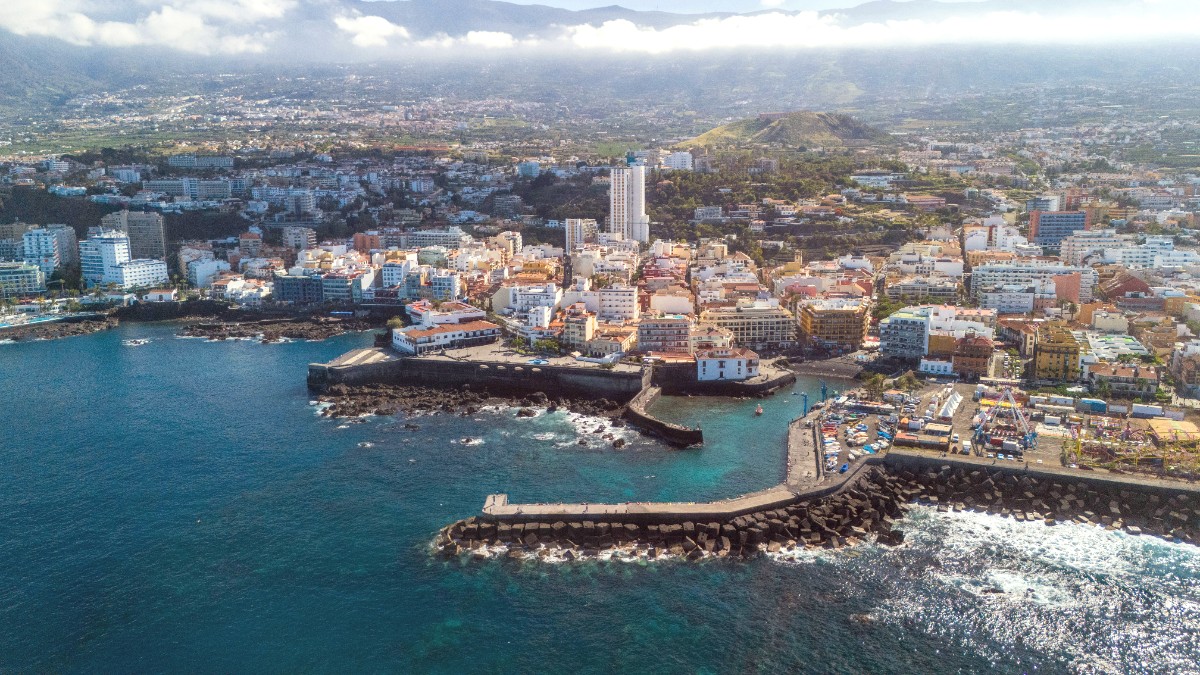
Tenerife, Canary Islands
The average annual temperature hovers around 20-22°C (68-72°F). This pleasant range defines the city's agreeable weather. Rainfall remains low throughout the year, with slightly more precipitation from November to February. Summers are typically dry. Puerto de la Cruz, located in the north, experiences more rainfall and cloud cover compared to the south of Tenerife, explaining the north's lush, green landscapes.
Moderate humidity levels persist year-round, averaging 60-70%. The island receives abundant sunshine throughout the year, averaging 6-9 hours per day. Even on cloudy days, the sun often breaks through.
Calima: This weather phenomenon originates from the Sahara Desert. It brings high temperatures, dry air, and fine dust or sand particles. Visibility can reduce significantly during a calima. While it can occur at any time, it appears more commonly in winter or spring. North vs. South Climate: The north of Tenerife, including Puerto de la Cruz, is generally greener, more humid, and often experiences more cloud cover ("panza de burro"). This area also sees occasional rainfall, especially in winter. The south, in contrast, remains drier and sunnier. This distinction shapes the landscapes and activities available in each region.
Mid-December to February, July-August
Warmest temperatures in winter, lively atmosphere, all attractions operate fully.
Higher prices for flights and accommodation. More crowded conditions. Book well in advance.
March-May, September-November
Comfortable temperatures for activities. Fewer crowds, relaxed experience. Better deals on flights and accommodation. Ideal for outdoor activities.
Weather can be slightly less predictable with a chance of occasional rain, especially in northern areas.
Early December, late February (outside Carnival), June
Lowest prices for flights and accommodation. Fewest crowds for a tranquil experience. Good for budget travelers.
Some smaller establishments might have reduced hours or close for staff holidays.
Spring (March-May) and Autumn (September-November) comfortable temperatures for hiking and outdoor activities. This avoids warmer summer heat and slightly wetter winter conditions, making long walks enjoyable.
June to October sea temperatures for swimming and enjoying the beaches. Whale and Dolphin Watching tours operate year-round, but calmer seas during summer can enhance sightings.
March-May & September-November are prime for hiking.
June-October offers the best sea temperatures.
Carnival (February/March) or local fiestas provide a lively experience.
Calm summer seas can lead to better whale and dolphin watching.
Low season months (e.g., June, early Dec) offer lower prices.
Spain belongs to the Schengen Area, a group of 27 European countries that have abolished passport and all other types of border control at their mutual borders.
Spain is part of the Schengen Area. A valid visa or visa-exemption for one Schengen country allows free travel within the entire area.
Always carry the correct documents for smooth entry.
Puerto de la Cruz offers options for every budget, from frugal to luxurious. Prices vary seasonally.
These daily estimates exclude international flights and provide a guide for typical expenses based on different travel styles.
| Category | Budget Traveler (Daily €) | Mid-Range Traveler (Daily €) |
|---|---|---|
| Accommodation | 30 - 60 | 60 - 120 |
| Meals | 20 - 35 | 35 - 70 |
| Total Daily Estimate | 70 - 150 | 140 - 300 |
Ensuring your health and safety remains a top concern when traveling.
No specific vaccinations are required for Spain. Routine vaccinations (MMR, DTP, Varicella, Polio, Flu) are always current. Consult your doctor or a travel clinic for personalized advice 4-6 weeks before your trip.
Sunburn/Heatstroke (high UV index - use High SPF sunscreen like Neutrogena Ultra Sheer Dry-Touch Sunscreen SPF 55, wear Hats), dehydration, minor cuts (carry Basic first aid kit), foot blisters, occasional jellyfish stings, and motion sickness.
Tap water is generally safe to drink, though desalinated. Many prefer Bottled water. Spain maintains high food hygiene standards. Practice good hand hygiene.
Emergency Number: Dial 112 for all emergencies (ambulance, police, fire).
Major public hospitals: Hospital Universitario de Canarias (La Laguna) and Hospital Universitario Nuestra Señora de Candelaria (Santa Cruz). Puerto de la Cruz has private clinics and a public health center. Pharmacies (Farmacias) are common, identified by a green cross sign.
European Health Insurance Card (EHIC) / Global Health Insurance Card (GHIC): EU/EEA, Swiss, and UK citizens should carry these for state-provided healthcare. For non-EU citizens, comprehensive travel insurance like World Nomads Travel Insurance or SafetyWing is useful to cover private medical treatment. Insubuy also provides coverage.
Purchase your policy as soon as you book your trip for immediate benefits.
Puerto de la Cruz a safe destination with low crime rates. Petty crime (pickpocketing) can occur in crowded tourist areas; awareness is advisable.
Tenerife is a volcanic island; Teide is monitored, but eruptions are rare. Wildfire risk increases in hot summer months. Coastal hazards (strong currents) are possible; observe flag warnings.
General Emergency: 112. Local Police: 092. National Police: 091. Medical Emergencies: 061. Keep your country's embassy/consulate details accessible.
Exercise standard precautions as you would in any tourist destination.
If your flights are delayed or canceled, you might be eligible for compensation.
AirHelp helps passengers receive up to €600 in compensation for delayed or canceled flights. This service provides a commission for successful claims.
Compensation claims are subject to specific EU regulations regarding flight disruptions.